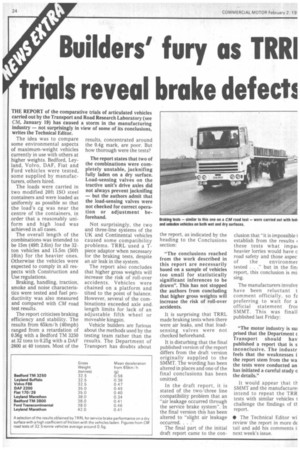Builders' fury as TRRI trials reveal brake defects
Page 26

If you've noticed an error in this article please click here to report it so we can fix it.
THE REPORT of the comparative trials of articulated vehicles carried out by the Transport and Road Research Laboratory (see CM, January 19) has caused a storm in the manufacturing industry — not surprisingly in view of some of its conclusions, writes the Technical Editor.
The idea was to compare some environmental aspects of maximum-weight vehicles currently in use with others at higher weights. Bedford, Leyland, Volvo, DAF, Fiat and Ford vehicles were tested, some supplied by manufacturers, others hired.
The loads were carried in two modified 20ft ISO steel containers and were loaded as uniformly as possible so that the load's cg was near the centre of the containers, in order that a reasonably uniform and high load was achieved in all cases.
The overall length of the combinations.was intended to be 15m (49ft 2.6in) for the 32ton vehicles and 15.5m (50ft 10in) for the heavier ones. Otherwise the vehicles were expected to comply in all respects with Construction and Use regulations.
Braking, handling, traction, smoke and noise characteristics were tested and fuel productivity was also measured and compared with CM road test results.
The report criticises braking efficiency and stability. The results from 65km/h (40mph) ranged from a retardation of 0.56g with a Bedford TM 3250 at 32 tons to 0.25g with a DAF 2800 at 40 tonnes. Most of the results, concentrated around the 0,4g mark, are poor. But how thorough were the tests?
The report states that two of the combinations were completely unstable, jacknifing fully laden on a dry surface. Load-sensing valves on the tractive unit's drive axles did not always prevent jacknifing — but the authors admit that the load-sensing valves were not checked for correct operation or adjustment beforehand.
Not surprisingly, the two and three-line systems of the UK and Continental vehicles caused some compatibility problems. TRRL used a Tpiece adaptor when necessary for the braking tests, despite an air leak in the system.
The report also concludes that higher gross weights will increase the risk of roll-over accidents. Vehicles were chained on a platform and tilted to the point of balance. However, several of the combinations exceeded axle and. length limits for lack of an adjustable fifth wheel or moveable kingpin.
Vehicle builders are furious about the methods used by the testing team rather than the results. The Department of Transport has doubts about the report, as indicated by the heading to the Conclusions section: "The conclusions reached from the work described in this report are necessarily based on a sample of vehicles too small for statistically significant inferences to be drawn". This has not stopped the authors from concluding that higher gross weights will increase the risk of roll-over accidents.
It is surprising that TRRL made braking tests when there were air leaks, and that loadsensing valves were not checked beforehand.
It is disturbing that the final published version of the report differs from the draft version originally supplied to the SMMT. The wording has been altered in places and one of the final conclusions has been omitted.
In the draft report, it is stated of the two/three line compatibility problem that an "air leakage occurred through the service brake system". In the final version this has been altered to "slight air leakage occurred. . . ."
The final part of the initial draft report came to the con elusion that "it is impossible I establish from the results ( these tests what impa( heavier lorries would have c road safety and those aspec of the environmer tested . . ." but in the fin; report, this conclusion is mi. sing.
The manufacturers involve have been reluctant t comment officially, so fa preferring to wait for a official statement frot SMMT. This was final] published last Friday: "The motor industry is SUJ prised that the Department lc Transport should hay published a report that is s inconclusive. The industr feels that the weaknesses i the report stem from the wa the tests were conducted an has initiated a careful study o the details."
It would appear that a SMMT and the manufacturel intend to repeat the TRR tests with similar vehicles t challenge the findings of tl report.
• The Technical Editor wi review the report in more cl€ tail and add his comments i next week's issue.




















































































































